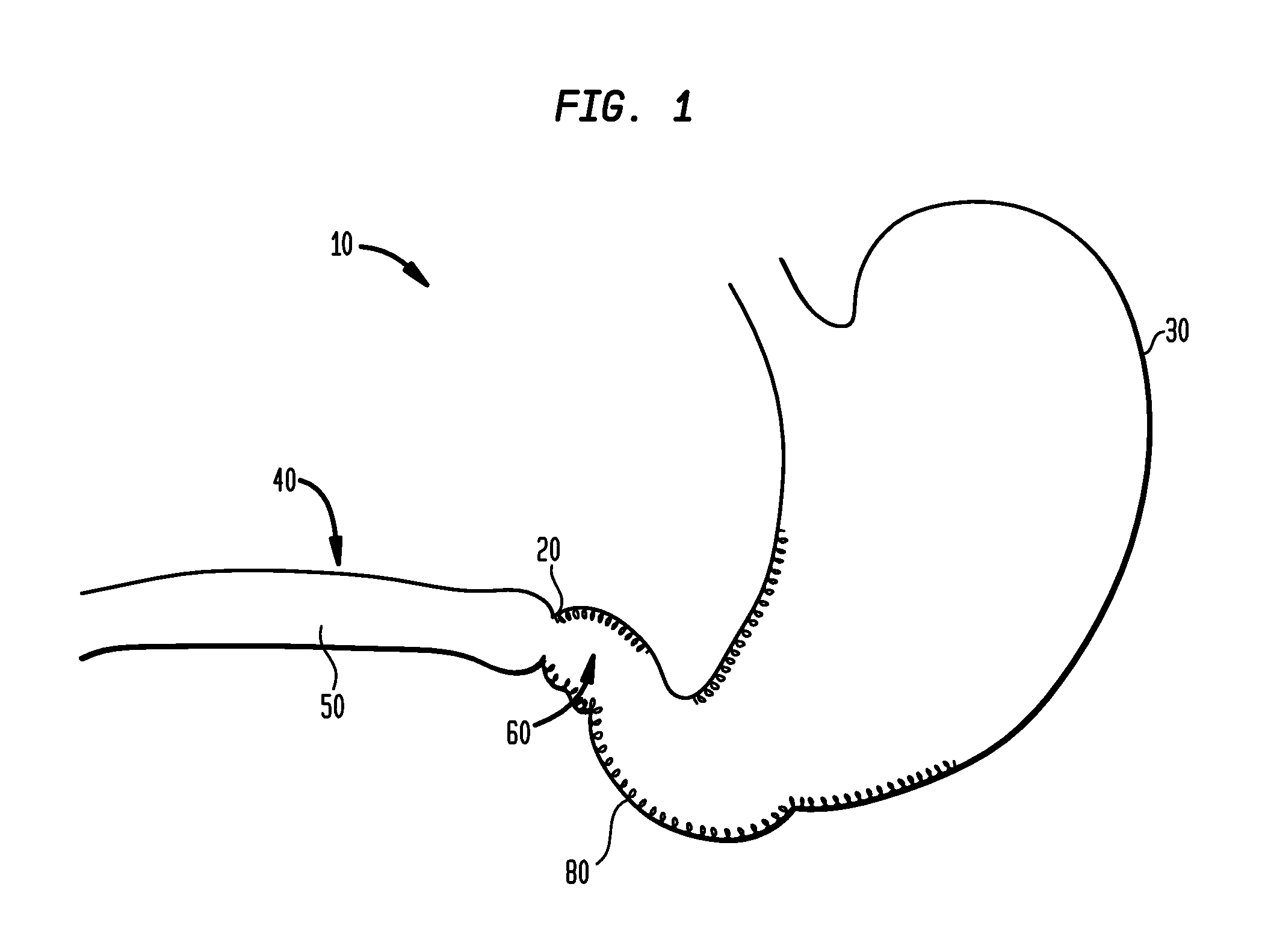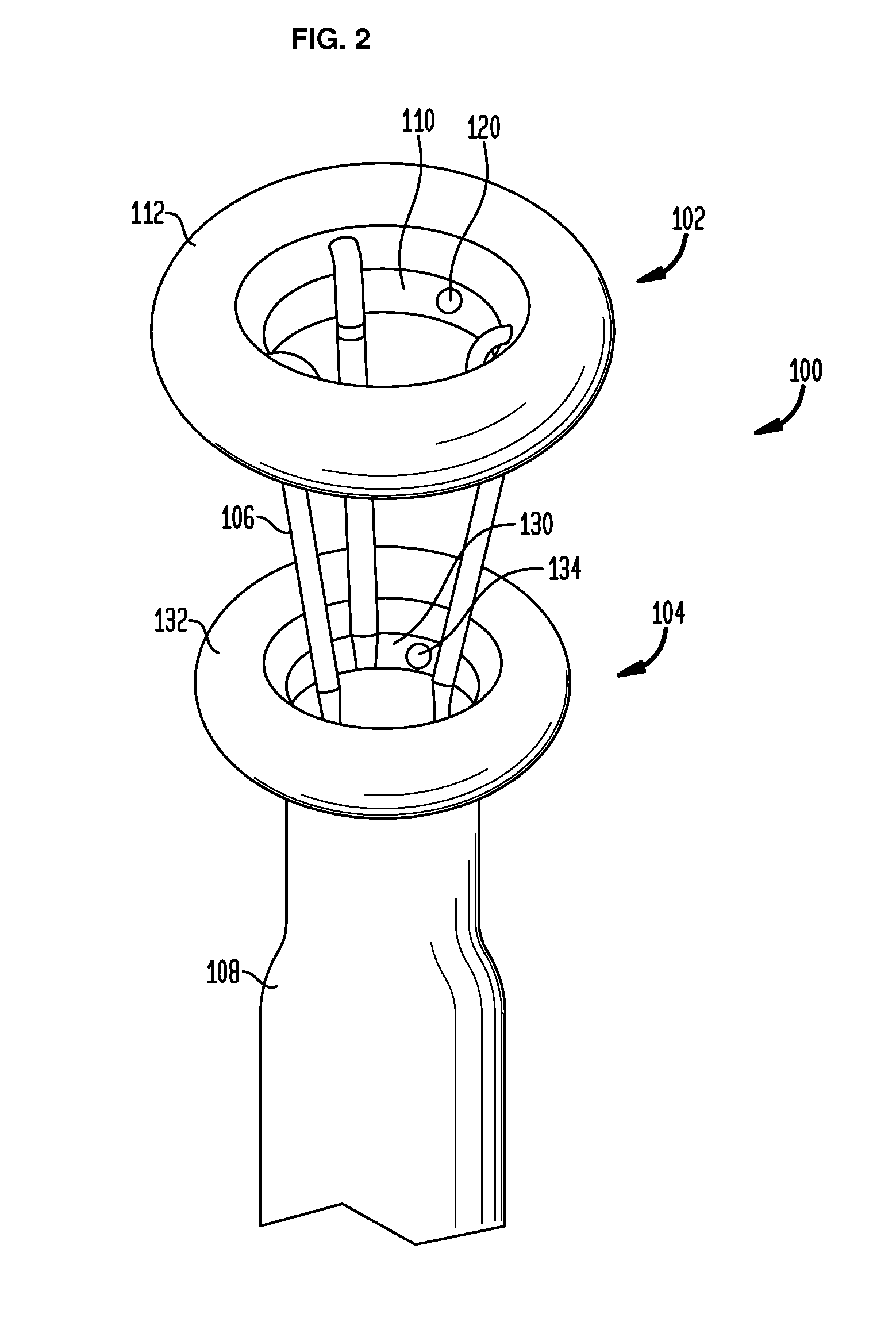[0012]A key
advantage of the present invention is that the bypass device can be placed and removed endoscopically through the patient's
esophagus in a minimally invasive
outpatient procedure. In addition, the bypass device expands to fit securely against tissue within the GI tract such that the position of the device is substantially maintained throughout the digestive process. Thus, the device is “self-anchoring” and does not require invasive tissue fixation within the patient's GI tract, thereby reducing collateral
tissue damage and minimizing its
impact on the digestive process. Also, unlike other more invasive procedures such as
gastric bypass, the bypass device of the present invention does not require any permanent restructuring of the GI
anatomy. Once the device is removed, the patient's GI tract should begin to function normally and in the same manner as if the device were never placed in the patient.
[0013]In a preferred embodiment, the hollow bypass sleeve is sized and shaped to extend from the distal opening of the duodenal anchor through the
duodenum and into a proximal portion of the
jejunum of the patient. The sleeve is positioned such that partially
digested food, i.e. chyme, moving through the
digestive tract passes through the interior of the sleeve. This inhibits the absorption of nutrients / calories in the upper segments of the
small intestine and delays mixing of chyme with digestive enzymes such that a quantity of food ingested by the patient will have a smaller caloric value with the sleeve in place.
[0014]In addition, several recent clinical studies have demonstrated that
gastric bypass surgical procedures for treating obesity, including Roux-en-Y, bilio-pancreatic diversion and
duodenum exclusion, show a rapid and remarkable reduction in clinical symptoms of diabetes including normalization of glucose and
insulin levels. These effects occur before any changes in obesity and suggest that the
duodenum may secrete molecular signals that cause
insulin resistance. Supportive data has also been demonstrated in rat models of diabetes. See, Rubino and Marescaux, Annals of
Surgery, 239 No. 1, 1-11 (January 2004), the entirety of which is incorporated herein by reference. Thus, the sleeve is designed to mimic the effects of bypassing the proximal portion of the
small intestine seen in these
surgical procedures. Specifically, it is believed that the sleeve will reduce hormonal triggers that may help to down-regulate the production of glucose, thereby resulting in a nearly immediate relief of Type-II diabetes symptoms. The stabilization or
elimination of Type-II diabetes symptoms will have a beneficial
impact on patient health and further
increase weight loss.
[0015]In a preferred embodiment, the gastric anchor defines an exterior wall housing an interior portion and an inlet in the exterior wall for delivering a fluid to the interior portion. The gastric anchor is configured for inflation by the fluid from the collapsed configuration to the inflated configuration. The gastric anchor will preferably have a substantially annular or toroidal shape in the inflated configuration with an outer
diameter sized to allow the gastric anchor to rest within the
distal portion of the
stomach without damaging the inner walls of the
stomach while preventing distal movement of the gastric anchor through the
pyloric sphincter, preferably between about 30 mm to about 70 mm. Of course, the exact
diameter of the gastric anchor will depend on individual patient's
anatomy. The annular shape allows for chyme to pass through a central opening in the gastric anchor from the
stomach to the
pylorus.
[0016]Similarly, the duodenal anchor preferably defines an exterior wall housing an interior portion and an inlet in the exterior wall for delivering a fluid to the interior such that the duodenal anchor is
inflatable from the collapsed configuration to the inflated configuration. The gastric anchor also preferably has a substantially annular or toroidal shape in the inflated configuration with an outer
diameter sized to allow the duodenal anchor to rest within the proximal duodenum without damaging the inner walls of the duodenum while preventing proximal movement of the duodenal anchor through the
pyloric sphincter, preferably between about 20 mm to about 40 mm depending on individual patient's anatomy. Again, the central hole within the duodenal anchor allows chyme to freely pass therethrough into the hollow sleeve.
[0017]The gastric and duodenal anchors are preferably coupled to each other by one or more flexible columns that extend through the pyloric
sphincter in the operative position. The flexible columns allow both anchors to move back and forth within the stomach and duodenum, respectively, with the natural
peristalsis motion of the patient. In the preferred embodiments, the gastric and duodenal anchors will periodically or continuously apply slight
contact pressure to the
distal portion of the pyloric
antrum and the proximal portion of the duodenum, respectively. In an exemplary embodiment, the flexible columns comprise a flexible material that has sufficient tensile strength to withstand the strong
peristalsis forces of the patient, such as
silicone or the like.
 Login to View More
Login to View More  Login to View More
Login to View More 


